
Swords and Amulets
According to legend, swords first appeared
in China during the time (2497 BC - 2398 BC) of the mythical Yellow Emperor (huangdi 黄帝).
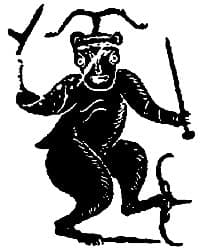 Chi You (蚩尤) was a tribal leader who died
fighting against the Yellow Emperor. Ancient texts
describe him as having a bull-shaped head made of copper with
his forehead made of iron.
Chi You (蚩尤) was a tribal leader who died
fighting against the Yellow Emperor. Ancient texts
describe him as having a bull-shaped head made of copper with
his forehead made of iron.
But, Chi You was a master blacksmith who smelted and forged the first Chinese swords. According to an ancient text on Chinese legends (song luo mi 宋罗泌), Chi You made the dagger-axe (ge 戈), lance (mao 戈), halberd (ji 戟), long spear (qiu mao 酋矛) and tribal spear (yi mao 夷矛).
Some of the edged weapons he invented can be seen in a rubbing from a Han Dynasty stone carving of Chi You at the left.
One of the most famous swordmakers in Chinese history was Ou Yezi (欧冶子) who lived during the Spring and Autumn Period (770 BC - 476 BC). He lived near Longyuan in a mountainous area of the State of Yue. This was considered an auspicious place to forge swords because it had seven natural springs which resembled the seven star constellation known as the Big Dipper.
Other famous swordmakers from the same time period were the husband and wife team of Gan Jiang (干将) and Mo Ye (莫邪) who crafted swords for King Hele (阖闾) of Wu (514 BC - 496 BC). Gan Jiang was a student of the master Ou Yezi. A pair of swords, one "male" (yang 阳) and one "female" (yin 阴), were made for King Hele and the two swords were named after the couple.
These legendary swords forged in a configuration of springs which resembled the Big Dipper, together with the notion of yin and yang, helped establish the belief that swords could not only be used in wars against human enemies but in battles against demons and evil spirits, as well.
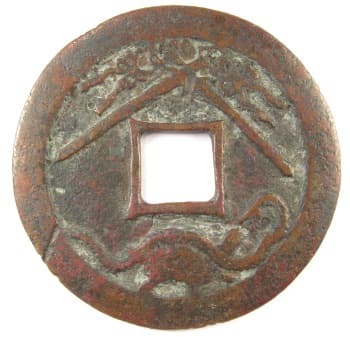 Starting about the time of the
Liu Song Dynasty (刘宋) (420-479 AD) of the Southern Dynasties,
swords began to assume an expanded role as instruments used in
religious, especially Daoist
(Taoist), rituals.
Starting about the time of the
Liu Song Dynasty (刘宋) (420-479 AD) of the Southern Dynasties,
swords began to assume an expanded role as instruments used in
religious, especially Daoist
(Taoist), rituals.
The ancient Daoist text "Daoist Rituals of the Mystery Cavern and Numinous Treasure" (dongxuan lingbao daoxue keyi 洞玄灵宝道学科仪) states that those who study Daoism must be able to cast outstanding swords capable of dispelling evil spirits.
In "Records of Knives and Swords" (daojian lu 刀剑录), Tao Hongjing (陶弘景) (451-536), a founder of a Daoist sect known as the Shangqing School (上清) during the Western Jin Dynasty (西晋) and who also established a Daoist mountain retreat at Maoshan, states that a true Daoist, by absorbing the powerful luster of a sword, is capable of driving away demons and healing illnesses.
For ritual purposes, swords made of peach wood began to appear following the Sui and Tang Dynasties because of the belief that peach wood could drive away evil spirits and control ghosts. This is because the Chinese word for peach (tao 桃) has the same pronunciation as the Chinese word for "flee" or "run away" (tao 逃).
Since swords could provide protection from evil influences, their very image soon became a powerful symbol that became popular for use on amulets.
The old amulet displayed above is a good example. Above the square hole are two crossed swords. Tied to the swords are fillets or ribbons which the Chinese believe can enhance the powers of the object to which they are tied.
One prominent characteristic of Chinese swords was that their blades were frequently engraved with an image of the Big Dipper (bei dou xing 北斗星) or Northern Ladle Constellation. The Chinese usually refer to this star constellation as the "Ladle".
The Big Dipper appears to rotate around the North Star (beijixing 北极星) which is seen as fixed and unmoving and, therefore, the center of the universe. Sima Qian (司 马迁) (145 BC - 86 BC), China's most famous ancient historian, described the Big Dipper as follows. The Big Dipper served as the Emperor's chariot and demonstrated his control of the four cardinal points by revolving around the center (North Star). The Big Dipper also keeps separate the yin and yang, maintains the balance of the Five Elements, and regulates the seasons and the calendar.
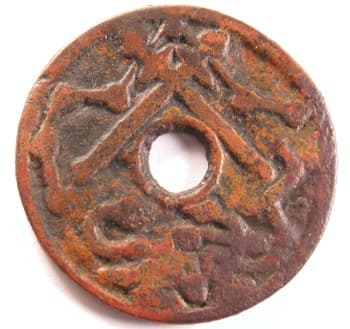 On swords
and amulets
the Big Dipper is seen as a series of seven dots (stars)
connected by a zigzag line.
On swords
and amulets
the Big Dipper is seen as a series of seven dots (stars)
connected by a zigzag line.
The symbol of the Big Dipper can be seen above the round hole on the ancient amulet at the left. The first star on the left is at about the eight o'clock position and the last star on the right is between the two o'clock and three o'clock positions.
The amulet also displays two crossed swords superimposed over the Big Dipper.
Unlike the swords shown on the amulet above, the swords here do not have ribbons tied to them since they can draw on the Big Dipper itself as an unlimited source of power.
However, most Chinese amulets with sword symbols usually only display one sword. Amulets with two swords are actually fairly uncommon.
The two sword symbol has its roots in the Gan Jiang and Mo Ye "yin and yang" swords of the Spring and Autumn Period mentioned above. But, the rise of religious Daoism during the Han Dynasty further strengthened the belief that the sword was an effective weapon against demons.
According to Daoist legend, Laozi, the author of the Dao De Jing, appeared before Zhang Daoling on "Crane Cry Mountain" (hemingshan 鹤鸣山) in Sichuan Province in the year 142 AD and proclaimed him a "Celestial Master" who was to deliver the people from the evils of the Han Dynasty. Laozi gave Zhang Daoling two swords, one male (yang) and the other female (yin), in order to carry out the mandate.
Zhang Daoling then proceeded to establish one of the major Daoist religious sects, known as "Five Bushels of Rice" ("Five Pecks of Rice" or Wudou Mi Dao 五斗米道).
There is also the belief that two swords represent two dragons. According to the "Biography of Zhang Hua" in the "Book of Jin" (晋书·张华传) compiled in 648 AD, Lei Huan (雷焕) obtained two swords in Fengcheng (丰城). He kept one sword and gave the other to his son Lei Hua (雷华). Later on, Lei Huan died. One day Lei Hua was carrying his sword while crossing the Yanping Ford (延平津) when the sword suddenly jumped out of its scabbard and sank into the river. Lei Hua ordered a servant to dive into the river and recover the sword. But under the water, the servant only saw two coiled and entwined dragons.
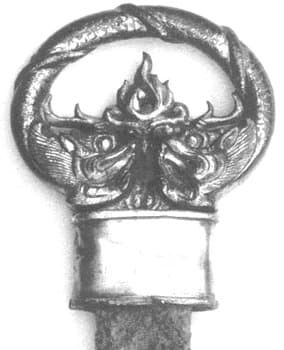 One of the most popular
traditional Chinese art themes has two dragons
chasing a pearl.
One of the most popular
traditional Chinese art themes has two dragons
chasing a pearl.
At the left is the pommel of an old Chinese sword with this motif that was discovered in an imperial tomb near Luoyang (洛阳) which is an ancient capital city located in Henan Province (河南).
The sword is believed to date from about 600 AD and is in the collection of the Metropolitan Museum of Art.
The pearl, which is frequently shown "flaming" as is the case here, is one of the Eight Treasures and therefore tends to enhance the value of an object.
The pearl is also seen as a symbol of perfection and enlightenment.
The pearl also closely resembles the moon. The various stages of the dragon devouring and disgorging the pearl can represent the waning and waxing of the moon and thus the endless cycle of transformation.
True Chinese charms and amulets did not begin to appear until sometime during the Han Dynasty and the sword, or pair of swords, as objects invested with power became frequently seen symbols from this time on.
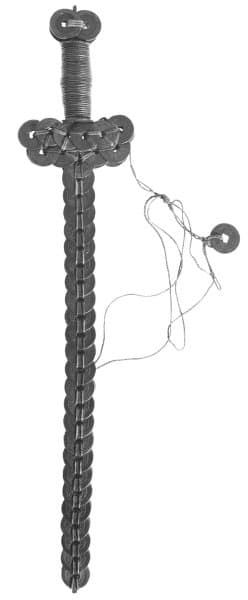 The sword's magical power to drive away evil
can also be seen in the uniquely Chinese "coin sword".
At the left is an old example of a coin sword which is in the
collection of the British Museum.
The sword's magical power to drive away evil
can also be seen in the uniquely Chinese "coin sword".
At the left is an old example of a coin sword which is in the
collection of the British Museum.
The coin sword consists of one or two iron rods as a foundation with real Chinese "cash" coins ingeniously fastened with string, cord or wire which should be red in color.
A typical coin sword is about 2 feet (0.6 meter) long and consists of around 100 ancient bronze coins.
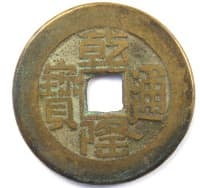 It is
usually considered better for all the coins to have been cast
during the reign of a single emperor.
It is
usually considered better for all the coins to have been cast
during the reign of a single emperor.
Most of the cash coins used to make this sword are from the reign of Emperor Gao Zong who ruled during the years 1736-1795 of the Qing (Ch'ing) Dynasty.
The inscription on these coins is qian long tong bao (乾隆通宝) and an example of a qian long tong bao coin is shown at the left for reference.
(Qian long tong bao coins were also used to make a "coin dragon" honoring the Qianlong Emperor (Emperor Gaozong) at the Forbidden City. Please see an interesting discussion of this dragon made of coins at Coin Dragon.)
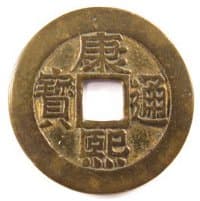
However, coins cast during the reign of Emperor Sheng Zu, who ruled during the years 1662-1722 of the Qing Dynasty, are considered to be the most effective for use in a coin sword because his reign lasted an entire sixty-year cycle of the Chinese calendar and thus represents "longevity".
The inscription on coins produced during the reign of Emperor Sheng Zu have the inscription kang xi tong bao (康熙通宝) and an example of this coin is displayed at the left.
Coin swords are frequently hung above the bed. For "feng shui" (风水) purposes, coin swords are hung on walls or above windows. It is believed that evil spirits would not dare molest the residents of the house because the sword resembles that wielded by Zhong Kui, the Daoist Immortal who is famous for being a slayer of evil demons.
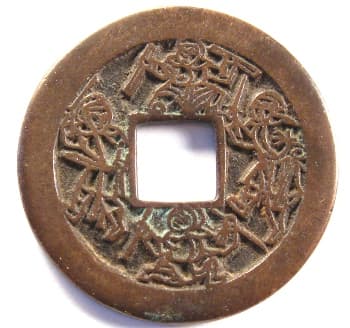
The Chinese actually have several persons closely associated with fighting demons and evil influences with magical swords.
A few are considered immortals or gods and can be easily identified by certain characteristics of dress or other symbols.
Sometimes, however, it is not clear who the swordsmen actually are.
For example, the amulet at the left shows four warriors. The warriors to the right and left of the square hole are brandishing swords.
The fighters above and below the square hole appear to be wielding other types of weapons.
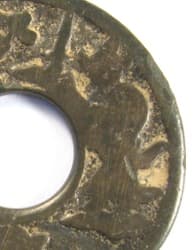 This
is an enlarged image from a Chinese zodiac amulet
showing an unknown deity with a sword.
This
is an enlarged image from a Chinese zodiac amulet
showing an unknown deity with a sword.
The inscription on the left side of the charm is chiling (敕令) which translates as "imperial order" or "edict".
The inscriptions on some amulets resembled official imperial documents. A command or edict issued by the emperor or a deified "high official" carried absolute authority.
In this case, the "edict" would be understood as to provide protection and to kill the evil spirits.
This type of "command" or "order" was frequently seen on old Daoist amulets where the "high official" was Laozi or the "God of Thunder".
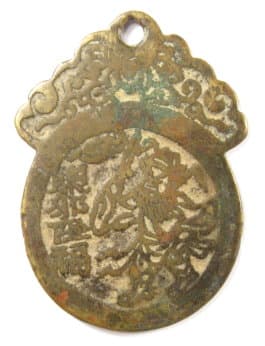
On the other hand, the fierce warrior with the heavy beard brandishing the sword in his right hand on this amulet can only be Zhong Kui.
Zhong Kui is a fearsome slayer of evil demons. The projections on each side of his hat are "demon-seeking" devices that point at unseen dangers.
Besides his physcial appearance, we know he is Zhong Kui because of the bat that is flying upside-down near the rim at the eleven o'clock position.
The bat is a symbol closely associated with Zhong Kui.
The Chinese inscription is qu xie jiang fu (驱邪 降福) meaning "Expel evil and send down good fortune (happiness)".
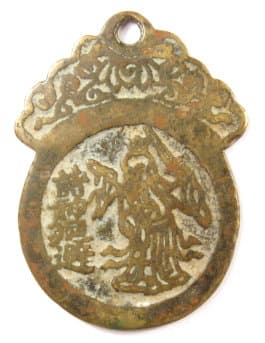
This amulet displays one of the Eight Daoist Immortals.
Lu Dongbin is holding his famous devil-slaying sword in his left hand.
As can be seen, the weapon is a traditional Chinese double-edged straight sword know as a jian (剑).
The whisk in his right hand, which allows him to walk on clouds or fly, helps identify him.
The Chinese legend is zhu shen hui bi (诸神回避) which translates as "evade all the spirits".
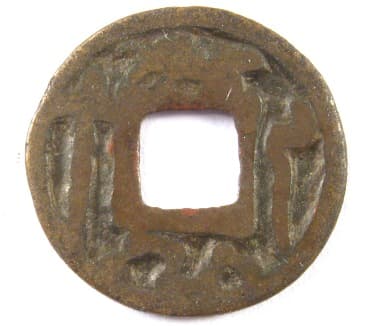 The characteristics of
the Chinese language combined with the authority of the
emperor has sometimes resulted in certain ancient Chinese
coins being perceived as having with special mythical powers.
The characteristics of
the Chinese language combined with the authority of the
emperor has sometimes resulted in certain ancient Chinese
coins being perceived as having with special mythical powers.
The "Large Coin Fifty" (da quan wu shi 大泉五十) cast during the reign of Wang Mang (7-23 AD) is one such coin.
This is an amulet but it is based on the "Large Coin Fifty" and its obverse side (not shown) is identical to the authentic coin.
The symbols on the reverse side include a sword to the left of the square hole and the seven-star Big Dipper below the hole.
A snake is to the right of the hole and a tortoise is above.
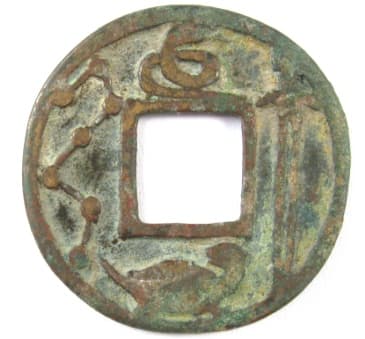
This is another amulet based on an actual ancient Chinese coin.
The obverse side (not shown) has the inscription wu xing da bu (五行大布) which translates as "large coin of the five elements". Authentic coins were cast in the year 574 AD during the reign of Emperor Wu of the Northern Zhou Dynasty.
The ancient Chinese believed that all of nature consisted of Five Elements: metal, wood, water, fire and water.
The reverse side, which is shown here, has a similar set of symbols as the amulet above. On the right is a sword, on the left is the Big Dipper, at the top is a coiled snake and at the bottom is a tortoise.
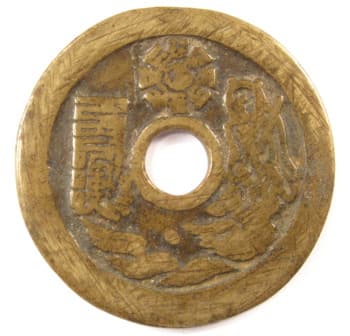
You may have noticed that the two amulets described above include the tortoise and the snake.
The tortoise and the snake, frequently shown with the tortoise coiled around the tortoise, is an ancient symbol representing Xuanwu. During the centuries following the Han Dynasty, Xuanwu gradually evolved into the popular Daoist god Zhenwu who is known as the Perfected Warrior and is associated with protection and healing.
The figure holding a sword across his chest on this amulet is Zhenwu. We know he is Zhenwu because he is standing on a tortoise and a snake.
The two amulets with the two crossed swords shown at the top of this page also show a tortoise entwined by a snake which symbolize Zhenwu, the Perfected Warrior.
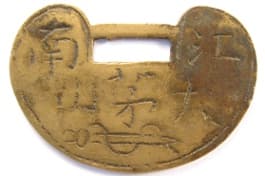
As has been seen, the sword is a powerful symbol used to slay evil spirits and is closely associated with Daoism.
The lock charm at the left displays a sword wrapped in a fillet or ribbon.
The three-character inscription across the middle says da mao shan (大茅山) which translates as "the great (Mount) Maoshan".
Mount Maoshan, located in Jiangsu Province, has historically been a major center of Daoism with many temples and many eminent Daoist priests. It is here where Tao Hongjing (陶弘景), mentioned above as the founder of the Shangqing Sect, established his mountain retreat.
A discussion of swords and Chinese gods would not be complete without mentioning Guan Di (关帝), also known as Guan Gong (关公), who is the God of War. Originally a beancurd seller, he joined forces with Liu Bei during the Three Kingdoms (220-280 AD) and became immortalized as a military hero. He is now a god that fights evil with a large broadsword. There is Qing (Ch'ing) Dynasty coin that many believe provides protection from evil because one of the Manchu characters in its inscription resembles the broadsword carried by the God of War.
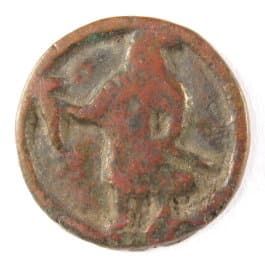
Other edged weapons are sometimes seen on old Chinese pieces.
For example, ancient Chinese chess pieces may display a warrior holding an edged weapon as illustrated here. More information can be found at Old Chinese Chess Pieces.
The Chinese halberd is also used as a symbol with a special meaning on Chinese charms. For a detailed discussion please see the following charms: "May your happiness be according to your wishes"; "Become wealthy according to your wishes"; "Longevity, wealth and honor and may gold and silver fill your halls".
A charm displaying the blade weapons used by the Boxers during the Boxer Rebellion is discussed in detail at Safe Journey Charm.
Finally, sometimes it is not necessary to use real swords, "coin swords" or even the image of swords as seen on amulets to obtain protection from demons. China has a plant known as calamus (chang pu 菖蒲) which is commonly referred to as "sweet flag". The leaves of this plant are long and stiff and resemble swords. For this reason, the Chinese like to hang "sweet flag" leaves above gates and doors, especially during the fifth day of the fifth month, to offer protection from evil spirits, disease and misfortune.
Return to Ancient Chinese Charms and Coins
 Chi You (蚩尤) was a tribal leader who died
fighting against the Yellow Emperor. Ancient texts
describe him as having a bull-shaped head made of copper with
his forehead made of iron.
Chi You (蚩尤) was a tribal leader who died
fighting against the Yellow Emperor. Ancient texts
describe him as having a bull-shaped head made of copper with
his forehead made of iron.But, Chi You was a master blacksmith who smelted and forged the first Chinese swords. According to an ancient text on Chinese legends (song luo mi 宋罗泌), Chi You made the dagger-axe (ge 戈), lance (mao 戈), halberd (ji 戟), long spear (qiu mao 酋矛) and tribal spear (yi mao 夷矛).
Some of the edged weapons he invented can be seen in a rubbing from a Han Dynasty stone carving of Chi You at the left.
One of the most famous swordmakers in Chinese history was Ou Yezi (欧冶子) who lived during the Spring and Autumn Period (770 BC - 476 BC). He lived near Longyuan in a mountainous area of the State of Yue. This was considered an auspicious place to forge swords because it had seven natural springs which resembled the seven star constellation known as the Big Dipper.
Other famous swordmakers from the same time period were the husband and wife team of Gan Jiang (干将) and Mo Ye (莫邪) who crafted swords for King Hele (阖闾) of Wu (514 BC - 496 BC). Gan Jiang was a student of the master Ou Yezi. A pair of swords, one "male" (yang 阳) and one "female" (yin 阴), were made for King Hele and the two swords were named after the couple.
These legendary swords forged in a configuration of springs which resembled the Big Dipper, together with the notion of yin and yang, helped establish the belief that swords could not only be used in wars against human enemies but in battles against demons and evil spirits, as well.
 Starting about the time of the
Liu Song Dynasty (刘宋) (420-479 AD) of the Southern Dynasties,
swords began to assume an expanded role as instruments used in
religious, especially Daoist
(Taoist), rituals.
Starting about the time of the
Liu Song Dynasty (刘宋) (420-479 AD) of the Southern Dynasties,
swords began to assume an expanded role as instruments used in
religious, especially Daoist
(Taoist), rituals.The ancient Daoist text "Daoist Rituals of the Mystery Cavern and Numinous Treasure" (dongxuan lingbao daoxue keyi 洞玄灵宝道学科仪) states that those who study Daoism must be able to cast outstanding swords capable of dispelling evil spirits.
In "Records of Knives and Swords" (daojian lu 刀剑录), Tao Hongjing (陶弘景) (451-536), a founder of a Daoist sect known as the Shangqing School (上清) during the Western Jin Dynasty (西晋) and who also established a Daoist mountain retreat at Maoshan, states that a true Daoist, by absorbing the powerful luster of a sword, is capable of driving away demons and healing illnesses.
For ritual purposes, swords made of peach wood began to appear following the Sui and Tang Dynasties because of the belief that peach wood could drive away evil spirits and control ghosts. This is because the Chinese word for peach (tao 桃) has the same pronunciation as the Chinese word for "flee" or "run away" (tao 逃).
Since swords could provide protection from evil influences, their very image soon became a powerful symbol that became popular for use on amulets.
The old amulet displayed above is a good example. Above the square hole are two crossed swords. Tied to the swords are fillets or ribbons which the Chinese believe can enhance the powers of the object to which they are tied.
One prominent characteristic of Chinese swords was that their blades were frequently engraved with an image of the Big Dipper (bei dou xing 北斗星) or Northern Ladle Constellation. The Chinese usually refer to this star constellation as the "Ladle".
The Big Dipper appears to rotate around the North Star (beijixing 北极星) which is seen as fixed and unmoving and, therefore, the center of the universe. Sima Qian (司 马迁) (145 BC - 86 BC), China's most famous ancient historian, described the Big Dipper as follows. The Big Dipper served as the Emperor's chariot and demonstrated his control of the four cardinal points by revolving around the center (North Star). The Big Dipper also keeps separate the yin and yang, maintains the balance of the Five Elements, and regulates the seasons and the calendar.
 On swords
and amulets
the Big Dipper is seen as a series of seven dots (stars)
connected by a zigzag line.
On swords
and amulets
the Big Dipper is seen as a series of seven dots (stars)
connected by a zigzag line.The symbol of the Big Dipper can be seen above the round hole on the ancient amulet at the left. The first star on the left is at about the eight o'clock position and the last star on the right is between the two o'clock and three o'clock positions.
The amulet also displays two crossed swords superimposed over the Big Dipper.
Unlike the swords shown on the amulet above, the swords here do not have ribbons tied to them since they can draw on the Big Dipper itself as an unlimited source of power.
However, most Chinese amulets with sword symbols usually only display one sword. Amulets with two swords are actually fairly uncommon.
The two sword symbol has its roots in the Gan Jiang and Mo Ye "yin and yang" swords of the Spring and Autumn Period mentioned above. But, the rise of religious Daoism during the Han Dynasty further strengthened the belief that the sword was an effective weapon against demons.
According to Daoist legend, Laozi, the author of the Dao De Jing, appeared before Zhang Daoling on "Crane Cry Mountain" (hemingshan 鹤鸣山) in Sichuan Province in the year 142 AD and proclaimed him a "Celestial Master" who was to deliver the people from the evils of the Han Dynasty. Laozi gave Zhang Daoling two swords, one male (yang) and the other female (yin), in order to carry out the mandate.
Zhang Daoling then proceeded to establish one of the major Daoist religious sects, known as "Five Bushels of Rice" ("Five Pecks of Rice" or Wudou Mi Dao 五斗米道).
There is also the belief that two swords represent two dragons. According to the "Biography of Zhang Hua" in the "Book of Jin" (晋书·张华传) compiled in 648 AD, Lei Huan (雷焕) obtained two swords in Fengcheng (丰城). He kept one sword and gave the other to his son Lei Hua (雷华). Later on, Lei Huan died. One day Lei Hua was carrying his sword while crossing the Yanping Ford (延平津) when the sword suddenly jumped out of its scabbard and sank into the river. Lei Hua ordered a servant to dive into the river and recover the sword. But under the water, the servant only saw two coiled and entwined dragons.
 One of the most popular
traditional Chinese art themes has two dragons
chasing a pearl.
One of the most popular
traditional Chinese art themes has two dragons
chasing a pearl.At the left is the pommel of an old Chinese sword with this motif that was discovered in an imperial tomb near Luoyang (洛阳) which is an ancient capital city located in Henan Province (河南).
The sword is believed to date from about 600 AD and is in the collection of the Metropolitan Museum of Art.
The pearl, which is frequently shown "flaming" as is the case here, is one of the Eight Treasures and therefore tends to enhance the value of an object.
The pearl is also seen as a symbol of perfection and enlightenment.
The pearl also closely resembles the moon. The various stages of the dragon devouring and disgorging the pearl can represent the waning and waxing of the moon and thus the endless cycle of transformation.
True Chinese charms and amulets did not begin to appear until sometime during the Han Dynasty and the sword, or pair of swords, as objects invested with power became frequently seen symbols from this time on.
 The sword's magical power to drive away evil
can also be seen in the uniquely Chinese "coin sword".
At the left is an old example of a coin sword which is in the
collection of the British Museum.
The sword's magical power to drive away evil
can also be seen in the uniquely Chinese "coin sword".
At the left is an old example of a coin sword which is in the
collection of the British Museum.The coin sword consists of one or two iron rods as a foundation with real Chinese "cash" coins ingeniously fastened with string, cord or wire which should be red in color.
A typical coin sword is about 2 feet (0.6 meter) long and consists of around 100 ancient bronze coins.
 It is
usually considered better for all the coins to have been cast
during the reign of a single emperor.
It is
usually considered better for all the coins to have been cast
during the reign of a single emperor.Most of the cash coins used to make this sword are from the reign of Emperor Gao Zong who ruled during the years 1736-1795 of the Qing (Ch'ing) Dynasty.
The inscription on these coins is qian long tong bao (乾隆通宝) and an example of a qian long tong bao coin is shown at the left for reference.
(Qian long tong bao coins were also used to make a "coin dragon" honoring the Qianlong Emperor (Emperor Gaozong) at the Forbidden City. Please see an interesting discussion of this dragon made of coins at Coin Dragon.)

However, coins cast during the reign of Emperor Sheng Zu, who ruled during the years 1662-1722 of the Qing Dynasty, are considered to be the most effective for use in a coin sword because his reign lasted an entire sixty-year cycle of the Chinese calendar and thus represents "longevity".
The inscription on coins produced during the reign of Emperor Sheng Zu have the inscription kang xi tong bao (康熙通宝) and an example of this coin is displayed at the left.
Coin swords are frequently hung above the bed. For "feng shui" (风水) purposes, coin swords are hung on walls or above windows. It is believed that evil spirits would not dare molest the residents of the house because the sword resembles that wielded by Zhong Kui, the Daoist Immortal who is famous for being a slayer of evil demons.

The Chinese actually have several persons closely associated with fighting demons and evil influences with magical swords.
A few are considered immortals or gods and can be easily identified by certain characteristics of dress or other symbols.
Sometimes, however, it is not clear who the swordsmen actually are.
For example, the amulet at the left shows four warriors. The warriors to the right and left of the square hole are brandishing swords.
The fighters above and below the square hole appear to be wielding other types of weapons.
 This
is an enlarged image from a Chinese zodiac amulet
showing an unknown deity with a sword.
This
is an enlarged image from a Chinese zodiac amulet
showing an unknown deity with a sword.The inscription on the left side of the charm is chiling (敕令) which translates as "imperial order" or "edict".
The inscriptions on some amulets resembled official imperial documents. A command or edict issued by the emperor or a deified "high official" carried absolute authority.
In this case, the "edict" would be understood as to provide protection and to kill the evil spirits.
This type of "command" or "order" was frequently seen on old Daoist amulets where the "high official" was Laozi or the "God of Thunder".

On the other hand, the fierce warrior with the heavy beard brandishing the sword in his right hand on this amulet can only be Zhong Kui.
Zhong Kui is a fearsome slayer of evil demons. The projections on each side of his hat are "demon-seeking" devices that point at unseen dangers.
Besides his physcial appearance, we know he is Zhong Kui because of the bat that is flying upside-down near the rim at the eleven o'clock position.
The bat is a symbol closely associated with Zhong Kui.
The Chinese inscription is qu xie jiang fu (驱邪 降福) meaning "Expel evil and send down good fortune (happiness)".

This amulet displays one of the Eight Daoist Immortals.
Lu Dongbin is holding his famous devil-slaying sword in his left hand.
As can be seen, the weapon is a traditional Chinese double-edged straight sword know as a jian (剑).
The whisk in his right hand, which allows him to walk on clouds or fly, helps identify him.
The Chinese legend is zhu shen hui bi (诸神回避) which translates as "evade all the spirits".
 The characteristics of
the Chinese language combined with the authority of the
emperor has sometimes resulted in certain ancient Chinese
coins being perceived as having with special mythical powers.
The characteristics of
the Chinese language combined with the authority of the
emperor has sometimes resulted in certain ancient Chinese
coins being perceived as having with special mythical powers.The "Large Coin Fifty" (da quan wu shi 大泉五十) cast during the reign of Wang Mang (7-23 AD) is one such coin.
This is an amulet but it is based on the "Large Coin Fifty" and its obverse side (not shown) is identical to the authentic coin.
The symbols on the reverse side include a sword to the left of the square hole and the seven-star Big Dipper below the hole.
A snake is to the right of the hole and a tortoise is above.

This is another amulet based on an actual ancient Chinese coin.
The obverse side (not shown) has the inscription wu xing da bu (五行大布) which translates as "large coin of the five elements". Authentic coins were cast in the year 574 AD during the reign of Emperor Wu of the Northern Zhou Dynasty.
The ancient Chinese believed that all of nature consisted of Five Elements: metal, wood, water, fire and water.
The reverse side, which is shown here, has a similar set of symbols as the amulet above. On the right is a sword, on the left is the Big Dipper, at the top is a coiled snake and at the bottom is a tortoise.

You may have noticed that the two amulets described above include the tortoise and the snake.
The tortoise and the snake, frequently shown with the tortoise coiled around the tortoise, is an ancient symbol representing Xuanwu. During the centuries following the Han Dynasty, Xuanwu gradually evolved into the popular Daoist god Zhenwu who is known as the Perfected Warrior and is associated with protection and healing.
The figure holding a sword across his chest on this amulet is Zhenwu. We know he is Zhenwu because he is standing on a tortoise and a snake.
The two amulets with the two crossed swords shown at the top of this page also show a tortoise entwined by a snake which symbolize Zhenwu, the Perfected Warrior.

As has been seen, the sword is a powerful symbol used to slay evil spirits and is closely associated with Daoism.
The lock charm at the left displays a sword wrapped in a fillet or ribbon.
The three-character inscription across the middle says da mao shan (大茅山) which translates as "the great (Mount) Maoshan".
Mount Maoshan, located in Jiangsu Province, has historically been a major center of Daoism with many temples and many eminent Daoist priests. It is here where Tao Hongjing (陶弘景), mentioned above as the founder of the Shangqing Sect, established his mountain retreat.
A discussion of swords and Chinese gods would not be complete without mentioning Guan Di (关帝), also known as Guan Gong (关公), who is the God of War. Originally a beancurd seller, he joined forces with Liu Bei during the Three Kingdoms (220-280 AD) and became immortalized as a military hero. He is now a god that fights evil with a large broadsword. There is Qing (Ch'ing) Dynasty coin that many believe provides protection from evil because one of the Manchu characters in its inscription resembles the broadsword carried by the God of War.

Other edged weapons are sometimes seen on old Chinese pieces.
For example, ancient Chinese chess pieces may display a warrior holding an edged weapon as illustrated here. More information can be found at Old Chinese Chess Pieces.
The Chinese halberd is also used as a symbol with a special meaning on Chinese charms. For a detailed discussion please see the following charms: "May your happiness be according to your wishes"; "Become wealthy according to your wishes"; "Longevity, wealth and honor and may gold and silver fill your halls".
A charm displaying the blade weapons used by the Boxers during the Boxer Rebellion is discussed in detail at Safe Journey Charm.
Finally, sometimes it is not necessary to use real swords, "coin swords" or even the image of swords as seen on amulets to obtain protection from demons. China has a plant known as calamus (chang pu 菖蒲) which is commonly referred to as "sweet flag". The leaves of this plant are long and stiff and resemble swords. For this reason, the Chinese like to hang "sweet flag" leaves above gates and doors, especially during the fifth day of the fifth month, to offer protection from evil spirits, disease and misfortune.
Return to Ancient Chinese Charms and Coins